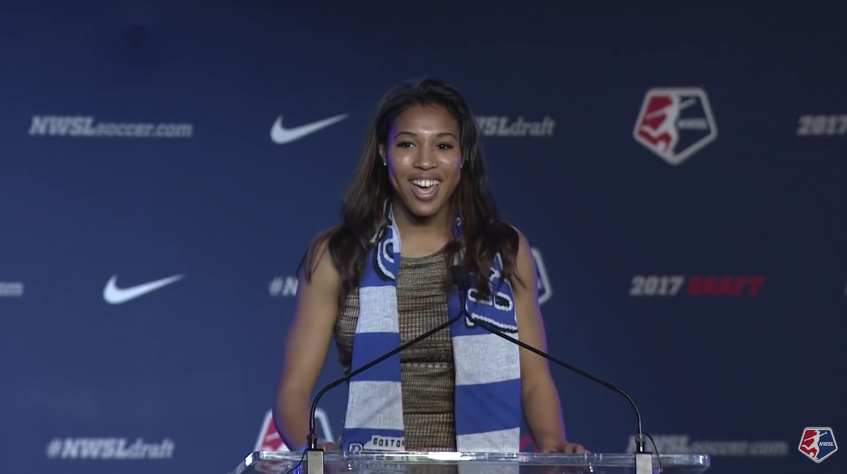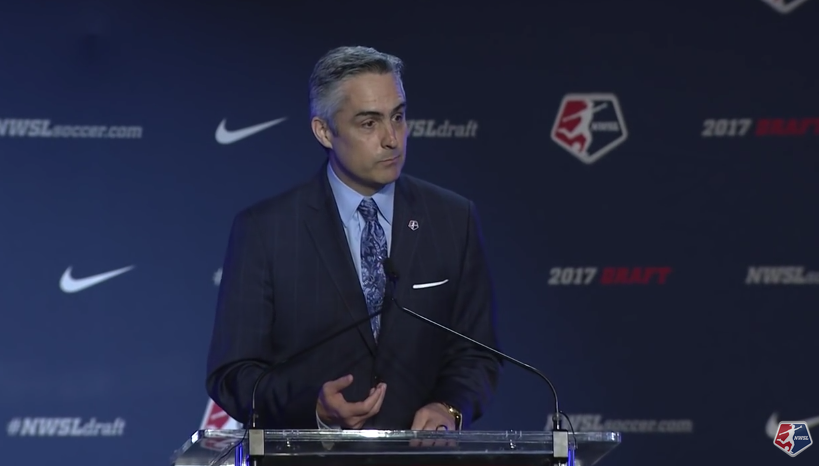Margaret Purce, a senior at Harvard, carefully considered her professional options.
She’d been pre-med, a reason she chose Harvard in the first place, but now law was calling her, and she weighed taking the LSATs.
Videos by VICE
Ultimately, however, she put both on hold. There was soccer to play, and on Thursday, the Boston Breakers made Purce, a speedy attacking forward, the ninth pick in the 2017 National Women’s Soccer League draft.
“Pre-med at Harvard was what I had my heart set on,” Purce said, standing in the Diamond Ballroom of the JW Marriott in Los Angeles, where the draft took place. “I went to school to go to school, but that doesn’t mean soccer has to be on the back burner. When I was a freshman, the only future I could see was U.S. Soccer. To have another paradigm, it is incredibly exciting.”
At the time Purce and her fellow 2017 draftees enrolled in college, the NWSL was a new iteration of a familiar idea—a women’s professional soccer league in the United States. Its predecessors, the WUSA and WPS, each lasted just three seasons before folding. So when the NWSL made it to a fourth season last year, many breathed a sigh of relief. Buoyed by the U.S. national team’s successful World Cup run in 2015, league attendance ballooned more than 21 percent across the board, and jumped another 10.1 percent in 2016 despite the USWNT’s early exit from the Olympics this summer.
More: Chips Episode 4: Can’t Talk Now, Louis Van Gaal Has Retired
Last week’s draft was perhaps the most ebullient yet for the NWSL, but it wasn’t entirely worry-free. Paradoxically, it is the travails of the national team that currently cast a shadow over the league, rather than the other way around, thanks to the unsettled labor dispute between the U.S. Women’s national team, whose members make up much of the star power within the league, and U.S. Soccer, who pays the salaries of those stars within NWSL. The public negotiation that played out through much of last year has given way to an eerie quiet, with the players firing their representative, Rich Nichols, in December and the two sides continuing under the rules of the expired deal for now. The national team enters 2017 without a collective bargaining agreement, meaning that either side can declare a work stoppage with 60 days notice.
Amid the uncertainty, national team stars like Alex Morgan and Crystal Dunn have left the NWSL for overseas assignments in Lyon and Chelsea, respectively. While they represent two of the league’s biggest names, the trickle of departures has not given way to a flood, and most around the league believe that the two sides will come to an agreement eventually, without too much collateral (or financial) damage.
“Two of the national team left,” NWSL commissioner Jeff Plush emphasized last week, as the second round of the draft played out on a nearby stage. “Not 24, two. And there are those coming back we know for sure, it’s already been announced. So we’re comfortable with the direction and the structure, knowing that we have to put pressure on ourselves to continually get better, continually invest more.”
Players who aren’t on the national team, for one, still earn a relatively meager amount (The Equalizer reports that salaries not subsidized by the federation can range from $7,200 to $39,700). While NWSL salaries have grown every year—and Plush said that they would increase “quite a bit” in 2017—most aren’t enough to live on, and athletes need to find outside sources of income to support their soccer careers. The number of players drafted to their local teams who said they expected to live at home this year was significant.
Purce acknowledged leaving a large amount of money on the table to play professional soccer rather than pursue a career in medicine or law, but as she pointed out, “This is for right now.” The hope is that the rising economics of the league eventually meets the minimum standard of living required to keep players around for the natural duration of their athletic careers.

Purce speaking at the 2017 NWSL draft. Courtesy NWSLsoccer/YouTube
Meanwhile, plenty of independent entities are eager to put their money in the NWSL—a new and encouraging reality for women’s soccer. Whereas previously teams used to shut down when the situation proved unstable or when owners wanted out, today’s franchises can attract buyers who are willing to keep the game going, such as businessman Elam Baer, who just bought FC Kansas City, and Steve Malik, who plans to relocate the defending champion Western New York Flash to Cary, North Carolina, a soccer hotbed that many observers believe offers more room for growth.
Expansion is clearly in the league’s plans for 2018, and multiple front offices have already begun roster planning around the inevitability of an expansion draft. The most talked-about markets and ownership groups right now are in Los Angeles, where LAFC will begin play in Major League Soccer in 2018 (and Mia Hamm is an active part of the ownership group), and Vancouver, where the Whitecaps could operate the NWSL team similarly to how the Portland Timbers run the Thorns, or Orlando City SC runs the Pride. There are advantages to ownership groups that already run MLS teams in terms of having an infrastructure in place from day one, but this is really about market reach.
“I think the biggest challenge for our interests and opportunities and sponsorship from a national point of view is that we’re not really a national property,” Plush said. “So we need to become a more national property. Part of that’s with broadcast and digital and media strategies, but part of is with some markets [out] West. We’re not in the number two and number four media markets in the United States right now. So I think California’s incredibly important.”
Plush also teased a new TV deal within the next 30 days that is “significantly more robust” than past efforts, which have meant a handful of games on the Fox Sports family of networks and the rest of the league’s offerings on YouTube. He said new sponsorships should come out of that television structure as well, something the league has been slow to add despite the attendance growth over the past few seasons.

NWSL commissioner Jeff Plush. Courtesy NWSLsoccer/YouTube
Until the national team and U.S. Soccer reach an agreement on the CBA, however, the league is in something of a holding pattern. Plush couldn’t commit to the national team players joining NWSL camps this spring because the commitment is not his to make. Scores of elite soccer players will be reporting to their clubs come March, but whether the best-known Americans will be among them remains unknown.
So it is a salve to the veterans of past failed soccer leagues here in the United States that the NWSL’s business model is closer to standing on its own, without relying on how the U.S. team does in a World Cup or an Olympics—neither of which is coming again until 2019.
“Hopefully, that delta of difference [between the NWSL and the national team’s success] is shrinking, because hopefully, we’re doing a better job year-over-year, we’re developing more equity in our marketplaces, we’re developing more professional staffs,” Plush said. “So eventually, we won’t need those big events to draft off of all the time. Always will be beneficial, though. When the women’s national team is playing and they’re doing great, that’s great for all of us. We need to shorten it so it’s not the end of the world in a year where they’re not as successful. Because that’s not going to happen every year.”
A league that succeeds, and remains in place, provides a professional alternative for soccer players in the United States. In Los Angeles last week, dozens of women who would otherwise be entering the professional world with only memories of former college soccer glory instead found new homes, where playing soccer could still be their job. So it was with Purce. And so it was with her new teammate, Morgan Andrews, the Breakers’ third overall pick out of USC. Thursday saw Andrews bouncing around the pressroom, exuding the energy that animates so many NWSL stakeholders these days.
“Hey, this is a movement!” Andrews told reporters. “This is pretty big. And I think there’s going to be some exciting things happening for Boston, exciting things happening for the league.”
Want to read more stories like this from VICE Sports? Subscribe to our daily newsletter.




